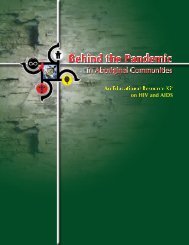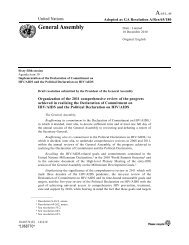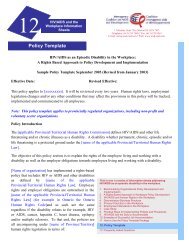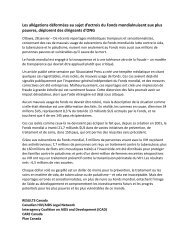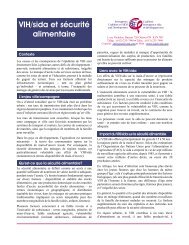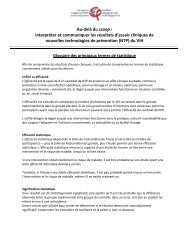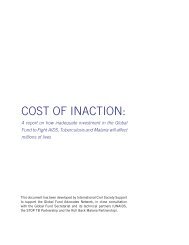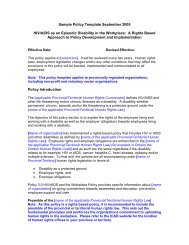HIV/AIDS and Prevention Options for Women - Interagency Coalition ...
HIV/AIDS and Prevention Options for Women - Interagency Coalition ...
HIV/AIDS and Prevention Options for Women - Interagency Coalition ...
You also want an ePaper? Increase the reach of your titles
YUMPU automatically turns print PDFs into web optimized ePapers that Google loves.
Additional resources are needed to research whether<br />
cervical barrier methods reduce <strong>HIV</strong> risk <strong>and</strong> <strong>for</strong><br />
research <strong>and</strong> development of microbicides. Research<br />
<strong>and</strong> development is largely dependent on public or<br />
donor funding, <strong>and</strong> probably will be until products are<br />
proven successful. Funding must come from the<br />
research institutions <strong>and</strong> donor agencies of<br />
industrialized countries, as well as from private<br />
foundations.<br />
Research <strong>and</strong> product development must be<br />
accompanied by program development <strong>and</strong> advocacy to<br />
ensure that women at risk will have access to safe,<br />
af<strong>for</strong>dable, <strong>and</strong> effective <strong>HIV</strong> prevention methods<br />
without delay. Programmers <strong>and</strong> policy makers can<br />
contribute to this ef<strong>for</strong>t by conducting the social science<br />
research necessary to underst<strong>and</strong>ing user needs <strong>and</strong><br />
dynamics. They can work to ensure meaningful<br />
community participation in testing new products, to<br />
maximize the scientific <strong>and</strong> ethical rigor of clinical<br />
trials. They can develop strategies <strong>and</strong> infrastructure <strong>for</strong><br />
introducing new methods <strong>and</strong> educating providers,<br />
programmers, <strong>and</strong> clients in their sustained use. These<br />
ef<strong>for</strong>ts will build on each other: introducing an existing<br />
method such as the female condom will contribute to a<br />
solid foundation of programs, providers, <strong>and</strong> users who<br />
are prepared <strong>for</strong> future methods such as cervical barriers<br />
<strong>and</strong> microbicides as they become available.<br />
Bibliography<br />
UN<strong>AIDS</strong>, Report of the Global <strong>HIV</strong>/<strong>AIDS</strong><br />
Epidemic. June 2000. Geneva, June 2000.<br />
UN<strong>AIDS</strong>, Report on the Global <strong>HIV</strong>/<strong>AIDS</strong> Epidemic<br />
2002. Geneva, July 2002.<br />
WHO/UN<strong>AIDS</strong>, The Female Condom: A guide <strong>for</strong><br />
planning <strong>and</strong> programming. Geneva, 2000.<br />
UN<strong>AIDS</strong>, Launching <strong>and</strong> promoting the female<br />
condom in Eastern <strong>and</strong> Southern Africa. Geneva,<br />
1999.<br />
Family Health International. FHI Research Briefs on<br />
the Female Condom No.2. Research Triangle Park,<br />
NC: FHI, 2001.<br />
Family Health International. FHI Research Briefs on<br />
the Female Condom No.5. Research Triangle Park,<br />
NC: FHI, 2001.<br />
Gollub EL. The female condom: tool <strong>for</strong> women’s<br />
empowerment. Am J Public Health 2000,<br />
90:1377-1381.<br />
Moench TR, Chipato T, <strong>and</strong> Padian NS. Preventing<br />
Disease by protecting the cervix: the unexplored<br />
promise of internal vaginal barrier devices. <strong>AIDS</strong><br />
2001, 15: 1595-1602.<br />
Kim Best. “New Barrier Devices May Be Easier to<br />
Use.” In Female Barrier Methods. Network Vol 20,<br />
Number 2, 2000<br />
Watts CH, Thompson WA, Heise LL. 1998. “The<br />
impact of microbicides <strong>for</strong> <strong>HIV</strong> prevention: Results of<br />
a mathematical modeling exercise.” Presentation at<br />
12th World <strong>AIDS</strong> Conference, Geneva, July 1998.<br />
Watts CH, Kumaranayake L, Vickerman P,<br />
Terris-Prestholt F. Estimating the Public Health<br />
Benefits of Microbicides in Low-Income Countries.<br />
New York: Rockefeller Foundation, 2002.<br />
Weiss E <strong>and</strong> Gupta GR. Bridging the Gap: Addressing<br />
Gender <strong>and</strong> Sexuality in <strong>HIV</strong> <strong>Prevention</strong>. Washington<br />
DC: International Center <strong>for</strong> Research on <strong>Women</strong>,<br />
1998.<br />
Web Sites<br />
www.who.int/reproductive-health/rtis/reuse.en.html<br />
www.microbicide.org<br />
www.fhi.org/en/gen/archives/newsarch41.html<br />
www.gmp.org<br />
www.global-campaign.org<br />
www.who.int/inf-fs/en/fact246.html<br />
ICAD’s aim is to lessen the impact of <strong>HIV</strong>/<strong>AIDS</strong> in resource-poor communities <strong>and</strong> countries. We are a coalition of<br />
Canadian international development organizations, <strong>AIDS</strong> service organizations <strong>and</strong> other interested organizations<br />
<strong>and</strong> individuals. ICAD wishes to thank the Global Campaign <strong>for</strong> Microbicides <strong>for</strong> its assistance in preparing this fact<br />
sheet. Funding <strong>for</strong> this publication was provided by Health Canada. The views expressed herein are solely those of the<br />
authors <strong>and</strong> do not necessarily reflect the official policy of the Minister of Health. Additional copies are available on<br />
the ICAD Web site at www.icad-cisd.com. Le feuillet « Le VIH/sida et les moyens de prévention pour les femmes » est<br />
disponible en français.



